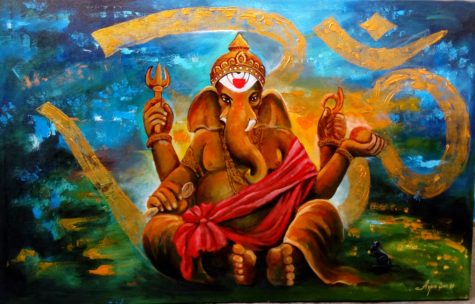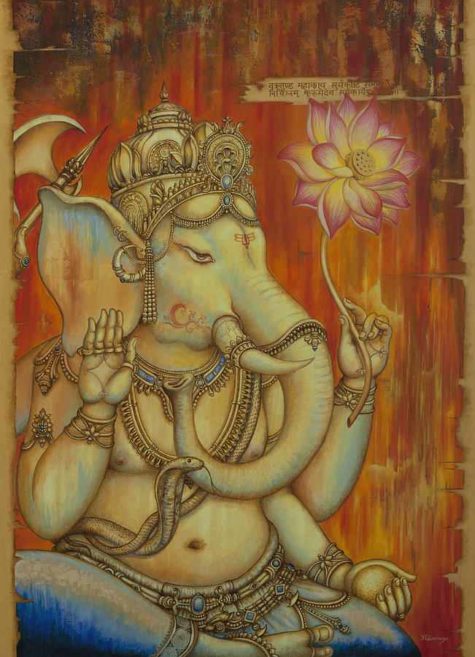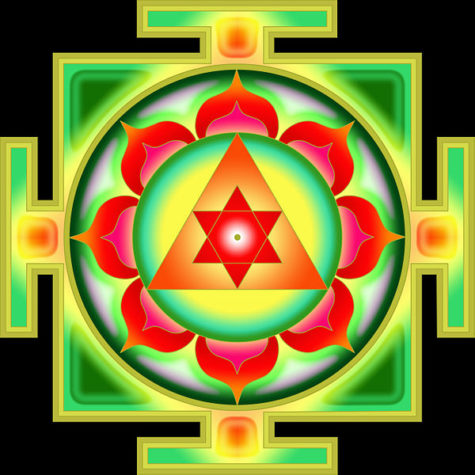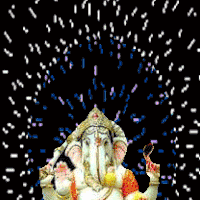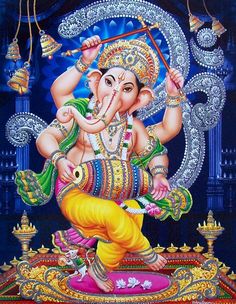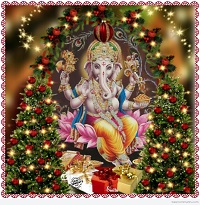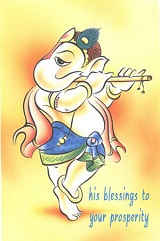Powers
Ganesha Lord of the Root Chakra
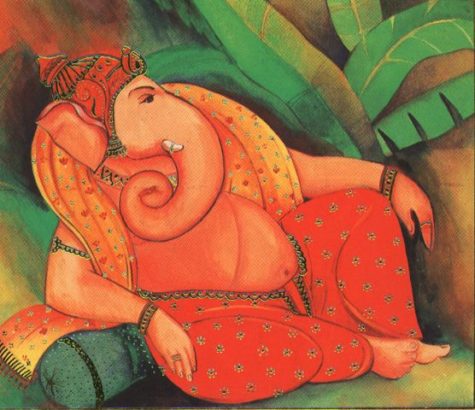
As per Kundalini Yoga Sutra, the human body receives its subtle cosmic energies from seven chakras that are ruled by different gods. The Muladhara is considered the “root” or “foundation” Chakra indicating “support” is one of the seven main chakras, located near the base end of the spinal column, primarily associated with the action of excretion. Muladhara Chakra is associated with survival and safety and teaches us the life lesson of standing up for ourselves.
An individual with a healthy Muladhara Chakra can be spotted out for a strong sense of security and practicality with a healthy physique. On the other hand, if this first Chakra is blocked, a person may lose the sense of belonging, have a weak physical structure, problematic bones, weight issues, and a fearful outlook towards life in general.
Lord Ganesha rules Muladhara Chakra, the root Chakra sssociated with family, stability and wealth. Mula means “main, root or original” and adhara means “base”, meaning that Lord Ganesha is the root cause of our familial happiness and domestic peace that are absent without his blessings.
Also in Ganapati Atharvashirsa it is given that “lord Ganesha continually dwells in the sacral plexus at the base of the spine, Muladhara Chakra. He resides permanently in every living being at the Muladhara. He guides all other chakras, thereby leading the forces that propel the wheel of life.”
Therefore, Lord Ganesha is the primal force that supports the foundation of every aspect of your life. He removes all the obstacles in all your undertakings. One should meditate on him every day in the morning. One can also use Ganesha Yantras or Rudraksha beads ruled by Lord Ganesha to strengthen your Root Chakra.
Source: The Rudra Centre
The Symbolic Representation of Ganesha
Ganesha is depicted small in stature, with a large, round abdomen, with four arms and the head of an elephant with a single tusk. In three of his hands he is holds an axe (ankush), a noose (sash) and sometimes a seashell. In some representations, with the fourth hand, he makes a gesture granting his divine favor, but more often he is holding a ladhu, a chickpea cookie. His eyes shine like two precious stones. He is riding or is accompanied by a rat, a former demon which he defeated and then accepted as his vehicle.
This representation may not be very attractive for the rational mind. His animal head and fat body attract children but for those who consider themselves to be adults, he seems ridiculous. It is a mistake however to deceive ourselves by his appearance, because Ganesha is the patron of refined beings who are not deceived by outer appearances. However those who cannot see the Divine in him and are distracted by his representation, become pray for the discursive mind, which represents the greatest obstacle on the spiritual path.
Accepting Ganesha as a Divine Force has the effect of controlling and calming the mind as well as in dissipating doubts. This is why he is considered to be the most suitable deity for removing obstacles. Believing in him generates a huge force, reversing the usual downward flow of energy, orientating it upwards and thus allowing the activation of the superior centers of force in our being. The divine Ganesha is unbreakable. He grants firmness to those who meditate upon him and invoke him at the beginning of all profane or spiritual actions.
In Mugdala Purana it is said: “Ganesha’s human body represents «tvam» (you), the elephant’s head is «tat» (Brahman) and together they signify the unity between these two aspects. Therefore Ganesha’s body is the visible representation of the highest reality, Brahman, expressed by «tat tvam asi» (you are That (Brahman or God)).”
Another explanation is that, generally, Ganesha’s head represents Atman, the Supreme Reality while his body, from the neck down, symbolizes maya, the principle of phenomenal existence. The involvement of Atman in the world is realized through mind and speech.
Article taken from Yoga Magazine magazine, issue no. 23
Ganesha and Science
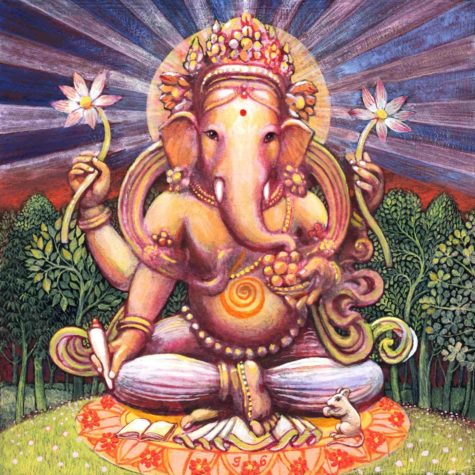
Tradition describes the entire universe as being contained in Lord Ganesha’s big belly. Thus we look upon Him as the overlord who holds sway over the material universe, the sum of cosmic mass. One of His potencies is gravity.
Gravity is a mysterious force to the scientist even today. It is the galactic glue that draws and holds larger mass together and gives order to the macrocosm. It is an instantaneous force, so that when one celestial body moves in a remote corner of a galaxy, all other masses through out the galaxy adjust simultaneously, even though it would take light, at its incredible speed, millions of years to travel the distance.
This implies that space and time are relative concepts and there is “something” that exists everywhere in the universe at once. Like gravity Lord Ganesha is totally predictable and known for orderliness. Without gravity, the known galactic systems could not exist; masses would stray apart; all organization of life as we know it would be impossible. Gravity is the basis of ordered existence in the macrocosm, and our loving Ganesha holds dominion over its mysteries.
Like gravity, Lord Ganesha is always with us, supporting and guiding our physical existence. He is a potent force in the universe, not a representation of potent universal forces. Corpulently built, Lord Ganesha is said to contain within Himself all matter, all mind. He is the very personification of material existence. We look upon this physical world as the body of Lord Ganesha.
In seeing and understanding the varied forces at work in the physical universe, we are seeing and understanding the powers and the being of Lord Ganesha. There is nothing that happens on this material plane of existence except that it is the will of God Shiva and minutely detailed by His beloved son Lord Ganesha. To Him we offer our reverent love and praise.
from Loving Ganesa
by Satguru Sivaya Subramuniyaswami
Who Is Ganesha?
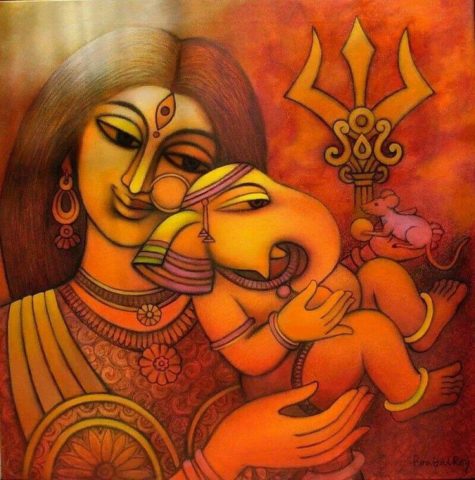
Ganesha is India’s cutest god. He has the head of an elephant on which is perched a dainty tiara, four pudgy hands joined to a sizeable belly with each hand holding its own symbolic object. One has a trishul, or a trident, the second, an ankush, or goad made from his very own broken tooth, the third hand elegantly holds a lotus and the fourth a rosary (which is sometimes replaced by modaks – his favourite sweet). His appetite for sweets is legendary and offerings of them are often left at his shrine.
Ganesha is famous not only for being a trickster and for his sense of humour, but equally for his wisdom. He is the son of Shiva (Destroyer in the Hindu Holy Trinity of Creator-Preserver-Destroyer) and Parvati (Shiva’s consort).
The chubby, gentle, wise, elephant-headed Ganesh, or Ganesha, is one of Hinduisms most popular deities. He is the remover of obstacles, the deity whom worshipers first acknowledge when they visit a temple. He is also patron of letters and of learning; he is the legendary scribe who, using his broken tusk, which he often holds, wrote down parts of the Mahabharata epic.
From Loving Ganesa
by Satguru Sivaya Subramuniyaswami
Lord Ganesha’s Tools
- Shankha
Conch
Ganesha listens to the puja conch’s loud sound, reminding Him of elephants’ trumpeting happily in the jungle. He summons, “Come one and all to Me and pray.”
- Ankusha
Goad
Loving Ganesha’s deliberate mind prods dullards on in their birth karmas whenever they tarry. with His ankusha He goads forward all souls that are moving too slowly.
- Parashu
Axe
Loving Ganesha knows there are difficult times ahead for some of His devotees. He protects them with His parashu in gentle ways from evils they have attracted.
- Pasha
Noose
Loving Ganesha’s provident mind, like the noose, draws close those He loves most dearly and reaches out to encircle and save strayed ones in extraordinary ways.
- Vajratrishula
Lightning Bolt
Loving Ganesha, like His brother Murugan, wields a sure weapon, the lightning bolt: spirit over mind, mind over matter, ruling both the higher and lower chakras.
- Chakra
Discus
Loving Ganesha holds the discus, symbol of the sun and of the mind, as the moon symbolizes the emotions. Employed as a weapon, it is the intellect divinely empowered.
- Modakapatra
Bowl of Sweets
Loving Ganesha is said to have a sweet tooth, or tusk. But the modaka ball is a symbol of what He loves most, moksha, liberation, the sweetest of all things sweet.
- Gada
Mace
Loving Ganesha is decisive and commanding, as symbolized by gada, His mace. He casts karmas back on devotees for resolution, never letting up until completion.
- Chhuri
Dagger
Loving Ganesha sometimes holds the dagger, keenly sharp, likened to the “razor’s edge,” the narrow and sometimes difficult path the spiritual aspirant must walk.
- Rudraksha Mala
Prayer Beads
Loving Ganesha sits at Lord Siva’s holy feet with japa mala, His prayer beads, in hand, waiting for instruction from the Supreme Lord of all the Gods, His father.
- Pushpashara
Flower Arrow
Loving Ganesha shoots flower-covered arrows from His sugar cane bow in guidance to devotees, so they will not wander too far from dharma’s path of true fulfillment.
- Amritakumbha
Pot of Nectar
Loving Ganesha receives a bath whenever a worshiper knocks his temples with arms crossed. The amrita flows from the sahasrara down to His seat at the muladhara’s base.
- Padma
Lotus
Ganesha wants devotees to learn confidence from the potential of the lotus flower: coming from the depths of the mud into the bud’s opening high above the water.
- Ikshukarmuka
Sugar Cane Bow
Loving Ganesha shows His generous nature of giving all that is good to devotees. His sugar cane bow shoots the kindest arrows, which are projections of His thought.
- Shara
Arrow
Loving Ganesha has power over thought, and each one hits its mark. Bow drawn, arrow aimed, He teaches us to precisely begin all undertakings with good intentions.
- Vina
Indian Lute
Loving Ganesha is sound in all its beauty and meaning. Siva is the ocean; Ganesha is its sound. Siva, the wind God; Ganesha its sound. Listen to the vina within and hear.
- Asura
Goblin
Loving Ganesha is not beyond frightening those who live in the chakra of fear by sending His ganas to lift them into a better life. Sometimes fear is a helpmate in need.
- Danda
Stick
Ganesha carries a short stick, a sign of authority, warning all not to impede the noble ways of dharma and restraining those who have as much as the thought to do so.
- Chamara
Fly-Whisk Fan
Loving Ganesha sits, as He always does, whisking away the past within the minds of devotees, young and old, rich and poor, educated and practical — because He is so wise.
- Kamandalu
Water Vessel
Loving Ganesha, dear to sannyasins, keeps their water vessel full. Symbol of fullness, meeting all needs, kamandalu eternally pours out, never needing to be filled.
- Dhanush
Bow
Loving Ganesha is discreet as He draws His bow and bends His thoughts into forms most helpful to His dear devotees. They all cherish all attentions with great ecstasy.
- Naga
Serpent
Loving Ganesha has a snake as His pet. Many are afraid of such creatures; but He tells us that it is the kundalini within all, and each one can rise above all adversity.
- Shalipallava
Rice Sprig
Loving Ganesha knows rice is the life-sustainer of villagers and city folk alike. Holding a sprig of paddy, He assures rains will come and all will be well at harvest time.
- Mudgara
Hammer
Loving Ganesha wields a mallet, badge of His office as Patron of Arts and Crafts, protector of all who build and shape, chisel and sculpt for the benefit of society.
- Shastra
Scripture
Loving Ganesha studiously edits all the scriptures on this planet and on others, too. His ever-ready, potent pen writes and edits life’s ordinances and comments on their meanings.
- Kalpavriksha
Wish-Fulfilling Tree
Loving Ganesha holds a sprig of the wish-fulfilling tree to tell us that all our wishes will be gratified. We have but to tell Him our needs, that is all, just tell Him.
- Parashvadha
Battleaxe
Loving Ganesha knows sometimes strong measures must be taken to fulfill a righteous goal, like crashing through a jungle. He uses a battleaxe as a mind force.
- Mahaparashu
Large Axe
Loving Ganesha often brandishes a big axe. This powerful weapon frightens off asuras and banishes malicious thoughts of those who intend harm to His devotees.
- Trishula
Trident
Loving Ganesha makes His way through the mind’s vast complexities with His abilities represented by trishula, His three-fold power: Love, Wisdom and Action.
- Narikela
Coconut
Loving Ganesha holds the coconut, symbol of the ego, soft and sweet inside, hard and rough outside. When we break a coconut to Him, we break the ego’s hold on us.
- Dhvaja
Flag
Loving Ganesha is the spirit of mirth. On festival days, the saffron Hindu dhvaja flies proudly over His temples, bringing crowds from near and far.
- Bhagnadanta
Broken Tusk
As the story goes, Ganesha broke off His right tusk in a sacrificial act to use it as a stylus while taking Vyasa’s dictation. Thus he teaches us that we must finish what we start.
- Pashanadarana
Pick Axe
Loving Ganesha is not naive by any means. He knows that trials await devotees, and that He must, in order to respond to prayers, pick, pick, pick away their mental dross.
- Agni
Fire
Loving Ganesha activates His fiery powers, capable of consuming our dross, of destroying our residual karmas, if we but consign our misdeeds to the purifying flames.
- Khadga
Sword
Loving Ganesha has a sword bejeweled with precious gems. It gives notice to those who respond only to fear of His enmity to crime and His abhorrence of hurting.
- Phala
Fruits
Loving Ganesha, dweller in the forest, enjoys all the Earth’s many life-sustaining fruits. He wants parents and children alike to stay healthy by eating lots of energy-giving fruits.
- Mulaka
Radish
Loving Ganesha, by His partiality for the simple radish, makes us grow food that is good for us. He knows devotees may grow more than they need just to please Him.
- Khetaka
Shield
Loving Ganesha holds the shield of divine security, symbol of His power to defend lands of the upright, to preserve traditions and to protect all souls on the spiritual path.
- Amra
Mango
Loving Ganesha says of the mango: “It was given to Me from Lord Siva’s own hand after performing My first wisdom act. It represents the highest spiritual fruition.”
- Tritiyakshi
Third Eye
Loving Ganesha, as do we all, has three eyes, not two, the third being the eye of the mind, of spiritual sight. With this eye He sees the reality behind the world’s seeming.
- Ratnakumbha
Pot of Gems
Loving Ganesha knows the magical power resident in gems. Diamonds, rubies, emeralds are like human souls, each with a different color, faceting, loveliness and value.
- Garitra
Grains
Loving Ganesha knows there are many kinds of people and they need variety in diet. He protects the cultivation of all kinds of grains that make their bodies strong.
- Ikshukanda
Sugar Cane
Loving Ganesha is fond of sugar cane, in fact, of anything sweet. Being the Lord all children adore, it is His joy to see their happy eyes light up when offering sugar cane.
- Madhukumbha
Pot of Honey
Loving Ganesha wears a wide smile across His face when offered a pot of sticky honey. It is, to Him, like moksha itself, the sweetest of all things sweet, worth any effort.
- Kadaliphala
Banana
Loving Ganesha has in His hand the banana, ripe and ready to eat. He looks at it longingly, yet would give it up in a moment should a devotee smell its fragrance.
- Yogadanda
Meditation Staff
Loving Ganesha rests His arm upon a short staff when talking to devotees and when in deep samadhi. He finds it helps Him meditate more effortlessly, more deeply.
- Trina
Grasses
Loving Ganesha knows that there are many kinds of animals, little and big. Each needs a special environment and foods, so He protects the grasses, little flowers and seeds.
- Tila Gola
Sesame Ball
Loving Ganesha teaches us that size may be immense but there is nothing too small to overlook. In His trunk is a sweet made of tiny sesame seeds, and He rides on a tiny mouse.
- Shuka
Parrot
Loving Ganesha delights when the parrot talks and shows he is happy. Perched in Ganesha’s hand, he greets all who come and go, giving his opinion when they are alone.
- Ananasa
Pineapple
Loving Ganesha holds the pineapple and is ready to slice it to share with those in His aura. Giving and sharing is our lesson from the sweet pineapple that He gives us.
- Mushika
Mouse
Ganesha’s companion, a mouse, attests to the all-pervasiveness of the elephant God. Mushika, the mount or vahana, carries Him into the mind’s every nook and cranny.
- Lambodara
Big Belly
Loving Ganesha has this world and all the billions of galaxies in His abundant belly. All known and unknown universes are contained within His prodigious girth.
- Swastika
Mark of Auspiciousness
Loving Ganesha’s good fortunes are represented by the swastika, a sign of luck and auspiciousness. Its crooked arms show how life is filled with change and indirection.
- Jambira
Lime
Loving Ganesha is a practical God, and it is His wish that all who know Him drink the juice from one of His favorite fruits. He wants them to be healthy and enjoy life.
- Aum
Cosmic Sound
Loving Ganesha is Aum. He is the A, the base sound of the universe; He is the U, the sound of the galaxies; and He is the M, the sound of the planets and the littlest stars.
- Shunda
Elephant Trunk
Loving Ganesha has a versatile trunk, and makes it known that it is a symbol of His capacity to always love His devotees. With it He reaches out to touch each of them.
- Nilapadma
Blue Water Lily
Loving Ganesha often sits by a lily pond, pondering the current state of the universe. His province is to see that all is in order until the next Great Dissolution, mahapralaya.
- Panasa Phala
Jackfruit
Loving Ganesha’s favorite, jackfruit, is a potato-like vegetable, a chewy nut and sweet yellow fruit all in one. Like the jack’s stem, our attachments, though small, are strong.
- Prabhavali
Fiery Arch
Loving Ganesha sits within an arch depicting creation, preservation and fiery dissolution. Above is the God of time, Mahakala, who ultimately claims everything.
- Dadima
Pomegranate
Loving Ganesha knows we may be led astray by ways of worldly people who eat meat. He offers us red dadimas, as if saying: “Its many pink seeds are so much better than flesh.”
- Nagapasha
Snake Cord
Loving Ganesha wears a snake around Him to tell us all that we have to be like Him and control our instinctive, animal mind. Yes, it is possible through the grace of this God.
- Kapittha
Wood Apple
Loving Ganesha loves wood apples, kapittha, called the elephant fruit. Sweet to eat, packaged in a tough shell, it is a pharmacy of ayurveda’s secret medicinal potencies.
- Laddu
Milk Sweet
Loving Ganesha was never accused of turning down a laddu, rich with milk, flour and sugar. Maybe it reminds Him of being young. Every young one loves sweets.
- Kavacha
Armor
Loving Ganesha’s sculpted form in temples and shrines worldwide is encased on festival days in silver and gold facsimiles. He likes splendor, pomp and adulation.
- Shashikala
Crescent Moon
Loving Ganesha, like His father, Siva, wears the crescent moon on His great head. It is a symbol of time’s passing, of auspicious moments and of the powers of the mind.
- Gam
Mantra
Loving Ganesha is invoked by devotees through this mystery mantra. Upon hearing it, He immediately responds. Easy of access, He never delays in solving our problems.
- Yajnopavita
Sacred Thread
Loving Ganesha wears across a massive shoulder the holy cord to remind us that we, too, can be twice born through His grace, that none is low and none is high.
- Jambu
Rose Apple
Loving Ganesha loves the rose apple among many other wonderful fruits and vegetables. He shows us the path to good health, harmlessness to creatures and love.
- Payasa
Pudding
Loving Ganesha is seen from time to time enjoying sweet tapioca pudding, likened to the love and kindness that comes from caring for others as one’s very own self.
- Sakti
Consort
Loving Ganesha is often seen with two female consorts, or shaktis. They represent ida and pingala, the two life currents, emotion and intellect, that hold us close to Earth.
- Muladhara Chakra
Base Center
Loving Ganesha, sitting on the four petaled muladhara, rules memory and knowledge as the gatekeeper to the six chakras above and the guard of the seven below.
- Vriksha
Trees
Loving Ganesha is the giver of gifts from healing trees, the practitioner of ayurveda, the great doctor who helps us gain the knowledge of health from medicinal plants.
From Loving Ganesa
by Satguru Sivaya Subramuniyaswami
Yantra of Ganesha
Meditating and focusing upon Ganesha’s yantra grants a state of inner balance.
Its background is vivid green. Green is a blend between warm yellow and cold blue; therefore it is color of balance. Focusing upon it generates its complementary color, red. Red is a color that can be easily noticed from a distance, being the symbol of life and inspiration, of revolutions and of the release from rules and restrictions.
The eight petal lotus stands for the eight aspects of Prakriti (the primordial nature):
- 1. Ether
- 2. Air
- 3. Fire
- 4. Water
- 5. Earth
- 6. Sattva
- 7. Rajas
- 8. Tamas
The six pointed star that is the color of saffron symbolizes the balance between the masculine and feminine energy generated by the overlapping between the masculine triangle with the apex pointed upwards and the feminine triangle with the apex pointed downwards.
The yellow triangle pointed upwards, where the 6 pointed star is depicted, stands for the masculine sap (the vital essence), the elixir of immortality. The color of this triangle is the same as Ganesha’s skin.
Bindu, the point located in the middle of the central triangle represents Ganesha himself. Meditation upon this bindu is the main goal for which the yantra is worshiped. Its color is golden yellow, a color that is appealing and relaxing at the same time.
Article taken from Yoga Magazine magazine, issue no. 23
The Five Shaktis of Lord Ganesha
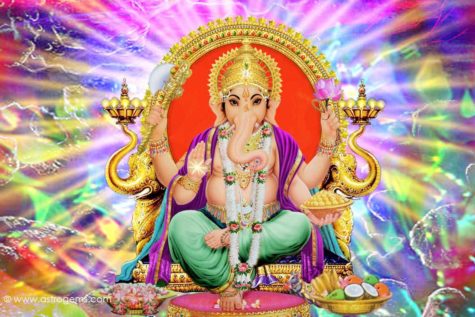
A Reverent Doxology by a Saiva Acharya
Loving Ganesha! Dear to Shiva’s men,
Within whose form the world of form resides,
Who earned the mango by a ponderous ken
And made the moon to wax and wane in tides.
Aum Ganesha! Loved by saints and sages,
Whose skillful arms five potent shaktis wield
To guide men now as in forgotten ages-
The seeker’s shield, the farmer’s fertile field.
Aum! Ganesha’s first shakti is home life,
Protection, harmony, fertility-
Respect becomes the man, as love the wife,
Obedience their cherished offspring’s glee.
Aum! Ganesha’s second shakti’s family –
By blood, by marriage and proximity.
Word and thought controlled, like minds agree,
While faithful friends preserve community.
Aum! Ganesha’s third shakti is the market,
Where commerce earns the earth stability,
Where forthright, selfless merchants, free from debt,
Conceive, produce, exchange prosperity.
Aum! Ganesha’s fourth shakti brings culture-
Refined expression, graceful artistry
In music, dance, in poetry and sculpture
Or common conduct performed consciously.
Aum! Ganesha’s fifth shakti is dharma-
Fair merit found in virtue’s charity
Where love of God does conquer ancient karma
And Liva’s slaves earn grace’s rarity.
Jaya Ganesha! Come, our hearts protect
From discord in the home, from strife with friend,
From business misfortune, from art’s neglect,
From soul’s dark night- these griefs asuric end.
